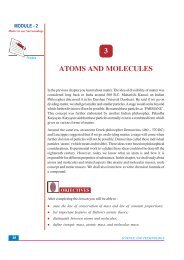Audio and Video programmes - The National Institute of Open ...
Audio and Video programmes - The National Institute of Open ...
Audio and Video programmes - The National Institute of Open ...
You also want an ePaper? Increase the reach of your titles
YUMPU automatically turns print PDFs into web optimized ePapers that Google loves.
Prog. Duration in Minutes<br />
Code Title <strong>of</strong> Programmes Language in Hindi in English<br />
212/V-11 Communication Hindi <strong>and</strong> English 16.00 16.35<br />
<strong>The</strong> programme deals with the means <strong>of</strong> communication <strong>and</strong> highlights various theories <strong>of</strong> communication.<br />
This programme depicts different types <strong>of</strong> means <strong>of</strong> communication including symbols <strong>and</strong> emotions. Besides<br />
marking differences between verbal <strong>and</strong> non-verbal communication, the programme also displays some<br />
devices through which communication is possible. <strong>The</strong> programme also explains the concepts like<br />
wavelength, frequency, amplitude <strong>and</strong> electromagnetic waves.<br />
212/V-12 Nuclear Energy Hindi <strong>and</strong> English 15.17 14.50<br />
This programme explains the meaning <strong>of</strong> nuclear energy, its uses <strong>and</strong> importance with the help <strong>of</strong> familiar<br />
examples. <strong>The</strong> main focus <strong>of</strong> the programme is to highlight the nuclear reactions like – nuclear fission <strong>and</strong><br />
fusion, <strong>and</strong> to explain the principle <strong>of</strong> nuclear reactor. A brief introduction to the status <strong>of</strong> nuclear energy in<br />
India has also been given in the programme. Besides describing the harmful effects <strong>of</strong> nuclear energy, the<br />
problem <strong>of</strong> disposal <strong>of</strong> the nuclear waste has also been explained in the programme. <strong>The</strong> programme<br />
concludes with a recap <strong>of</strong> the programme.<br />
212/V-13 Energy Hindi <strong>and</strong> English 14.40 14.40<br />
<strong>The</strong> programme explains the term ‘energy’ <strong>and</strong> describes different kinds <strong>of</strong> energy. Different types <strong>of</strong><br />
energies like kinetic energy, potential energy, radiation energy, magnetic energy <strong>and</strong> chemical energy have<br />
been highlighted in the programme. A few natural resources from which energy is drawn have also been<br />
given in the programme.<br />
212/V-14 Tele- communication Hindi <strong>and</strong> English 17.40 17.40<br />
This programme deals with the different types <strong>of</strong> waves used for communication. To begin with, a radio<br />
panel has been displayed to indicate medium waves (MW), short waves (SW), frequency modulation<br />
(FM) etc. Some devices which use electromagnetic waves for communication have also been highlighted.<br />
<strong>The</strong> programme also talks about video <strong>and</strong> sound signals <strong>and</strong> methods <strong>of</strong> their recording. Besides explaining<br />
the working <strong>of</strong> telephone <strong>and</strong> other wireless devices, some <strong>of</strong> the advanced technologies <strong>of</strong> communication<br />
like computer <strong>and</strong> compact disc have also been described in the programme.<br />
212/V-15 Universe Hindi <strong>and</strong> English 15.30 16.00<br />
<strong>The</strong> programme describes the formation <strong>of</strong> day <strong>and</strong> night <strong>and</strong> different seasons by correlating them with<br />
different types <strong>of</strong> motions <strong>of</strong> the earth. Besides explaining the different phases <strong>of</strong> the moon, reasons <strong>of</strong> lunar<br />
<strong>and</strong> solar eclipses have also been explained with the help <strong>of</strong> illustrations <strong>and</strong> live visuals. Different types <strong>of</strong><br />
constellations have also been described. Further, while differentiating between stars <strong>and</strong> planets, a brief<br />
description <strong>of</strong> the nine planets <strong>of</strong> the solar family has also been given with the help <strong>of</strong> animated visuals.<br />
212/V-16 Motion <strong>of</strong> Molecules Hindi <strong>and</strong> English 11.23 09.55<br />
This programme explains the nature <strong>of</strong> movement <strong>of</strong> a molecule. <strong>The</strong> process <strong>of</strong> diffusion has been<br />
demonstrated in air as well as in water. <strong>The</strong> programme shows the involvement <strong>of</strong> such movements in food<br />
<strong>and</strong> O 2<br />
molecules in the cells <strong>and</strong> the elimination <strong>of</strong> wastes i.e., elimination <strong>of</strong> CO 2<br />
from the cell. <strong>The</strong><br />
process <strong>of</strong> osmosis has been explained with the help <strong>of</strong> experiment. <strong>The</strong> programme shows the nature <strong>of</strong><br />
fluids with regard to their viscosity by taking several examples like petrol, mobil oil etc. A comparison<br />
between the movements <strong>of</strong> objects in a factory <strong>and</strong> the movement <strong>of</strong> molecules has also been shown in the<br />
programme.<br />
25

















